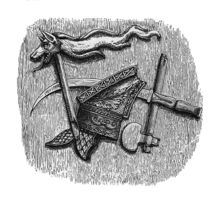Comosicus was a Dacian king and high priest who lived in the 1st century BC.[1][2] The only reference to Comosicus is a passage in the writings of the Roman historian Jordanes.
| Comosicus | |
|---|---|
| Dacian king | |
 symbols of the Dacian kingdom | |
| Reign | 9 BC(?) -30s AD. |
| Predecessor | Cotiso |
| Successor | Scorilo |
Sources
editJordanes refers to Burebista as king of Dacia, but then goes on to discuss a high priest called Dicineus who taught the Dacians astronomy and whose wisdom was revered. He then says that "after the death of Dicienus, they held Comosicus in almost equal honour, because he was not inferior in knowledge. By reason of his wisdom he was accounted their priest and king, and he judged the people with the greatest uprightness. When he too had departed Coryllus ascended the throne as king of the Goths [Getae] and for forty years ruled his people in Dacia."[3]
Interpretations
edit"Coryllus" is widely believed to be identical to Scorilo, but there is no other evidence concerning Comosicus. Jordanes' ambiguity about the status of Dicineus in relation to Burebista possibly arises from the fact that after Burebista's assassination in 44 BC his empire dissolved, with the exception of the nucleus around the Orăștie Mountains,[4] while the rest divided into various kingdoms.[5] The concept of a priest-judge may have provided a trans-tribal unity. Louis Marin refers to Dicineus as "a sort of double for the king, a double who also stood in for Burebista's successor Comosicus", since Comosicus embodies a "twin royalty, political and religious".[6]
Since Comosicus's successor Scorilo appears to have come to power sometime between 30 and 40 AD, Comosicus's accession immediately after Burebista would imply an impossibly long reign[citation needed]. Other evidence suggests that a ruler called Cotiso was the dominant power in the late 1st century BC. Ioana A. Oltean argues that Comosicus probably succeeded Cotiso at some point during the campaign of Marcus Vinicius in the Dacian area c.9 BC and ruled until 29 AD.[1] He may have been the first Dacian ruler to combine the positions of priest and king.
External links
edit- Enciclopedia Dacia - Comosicus (Romanian)
References
edit- ^ a b Oltean, Ioana A. (2007). Dacia: Landscape, Colonization and Romanization. p. 49; 72.
At least two of his successors, Comosicus and Scorillo/Corilus/Scoriscus, became high priests and eventually Dacian kings
- ^ Taylor, Timothy (2001). Northeastern European Iron Age pages 210-221 and East Central European Iron Age pages 79-90. Springer Published in conjunction with the Human Relations Area Files. p. 215. ISBN 978-0-306-46258-0.
- ^ The Origin and Deeds of the Goths
- ^ Pippidi 1976, p. 116-117.
- ^ Strabo, Geography, VII:3.5
- ^ Marin, Louis, "Utopian Discourse and Narrative of Origins", On Representation, Stanford University Press, 2001, pp.109; 415.
Works cited
edit- Pippidi, Dionisie M., ed. (1976). "Dictionar de istorie veche a României: (Paleolitic-sec.X)". Dicţionar de istorie veche a României: (paleolitic – sec. X) (Dictionary of Romanian old history). Bucharest: Editura ştiinţifică şi enciclopedică.